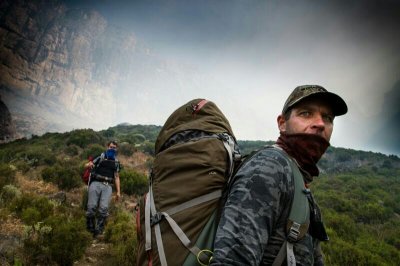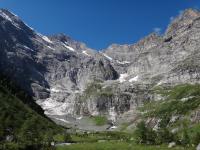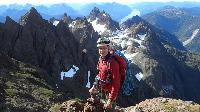The term "Langalibalele Pass" was originally a reference to a pass used by the Hlubi people led by Chief Langalibalele. The route was mainly used for cattle theft, but after Langalibalele's Rebelion ended in 1873, this pass fell into disuse. The name "Langalibalele Pass" was then appropriated to the "Bushman's River" Pass. The original Langalibalele Pass is still usable and is now known as "Hlubi" Pass.
This pass is definitely one of the easiest routes to the escarpment. It tops out between the Sanqebethu and Durnford ridges. With a good path along the entire route and no overly steep sections, its a good route for newbies.
Rating:
* * * (2/10)
Difficulty of the pass is rated from 1-10 (10 being very difficult, only to be attempted by the fit and experienced). A subjective quality rating is indicated by the number of stars (1 being low, 5 being the highest). Factors such as scenic beauty and overall experience come into play here, which may differ from person to person.
Access:
The pass is accessed via the Langalibalele Ridge route. It is a 6km walk from the car park to the contour path. The path up Langalibalele Ridge is steep and long, but the views from the ridge are well worth the effort.
Details:
The distance from Contour path to the top of the pass is 3 km with an altitude gain of 700m. The pass itself starts around 500m from the contour path at approximately 2400m, after a short traverse and a river crossing under a small waterfall.
Route:
From the contour path you ascend up a steep bank, the route crosses from the north slope of Langalibalele Ridge to the south slope. This is followed by a slight downhill traverse which ends at a small waterfall a few hundred metres later.
There is a good easy to follow path the entire way to the summit of the pass. The pass starts after a small waterfall. Start by following the obvious steep path up the north side of the slope next to the waterfall. The path then takes a sharp turn up towards the escarpment. This first section is the steepest part of the pass. The path leads straight up a moderately steep bank. This first assault is fairly short. The middle section of the pass is not difficult, altitude is gained fairly gradually. Near the middle of the pass there is a short section where the path is hard to follow. There are cairns on top of large boulders to guide you through and across the stream that flows off the slopes of Erskine Peak.
The top section of the pass is steeper than the middle section, but not particularly difficult. The summit visible from near the bottom of the pass is the actual summit and the pass is as easy as it seems. The pass tops out around 50m below the Carbineers' Grave - the final resting place of the 5 non-Hlubi casualties of the skirmish that happened here in 1873.
Finding the pass from the escarpment:
The pass is fairly easy to find from the escarpment, provided you end up in the right valley! The pass is marked by a medium sized cairn on the watershed. The pass tops out at the lowest point on the watershed in the saddle between Bannerman Face and Erskine. The Carbineers' Grave (a large pile of rocks with a large metal cross) is near the summit of the pass - if in doubt, the graves confirm that you are in the right place.
A common route is to traverse from Bannerman Pass to Langalibalele Pass. This route is often attempted by beginners. This is NOT recommended for those who are unfamiliar with the area as the traverse over from the Sanqebethu ridge will land you in the wrong ridge in Lesotho, thus making it very easy to get lost. To find the pass from Bannerman Pass, head up the Sanqebethu ridge at roughly a 45 degree angle from the top of Bannerman Pass (i.e. half the angle between following the rock face above Bannerman Pass and the Sanqebethu Ridge summit itself). Near the top of the ridge, traverse towards the escarpment edge and find one of the large gaps in the summit rock band. As you cross over the top of the ridge you will see a large valley between 2 ridges. Follow the west facing ridge, slowly losing altitude. There is a large rock band that extends from quite far up the ridge, traverse below this. The ridge tapers off towards a valley - as you reach this section, avoid losing too much altitude and follow the contour around the corner to the other side of the ridge. You will see a river below you, drop down to this river, cross the river and then once again traverse without losing too much altitude until you are on the watershed. Follow the watershed until you reach the saddle below Erskine Peak. There is a cairn marking the top of the pass here. The path starts about 20m downhill from here.
Overnight Spots:
There are a few decent spots to pitch tents near the top of Langalibalele Ridge, the spot at the base of the pass itself is particularly good being near to water. Near the summit one can find Bannerman Cave or can pitch a tent near the river that flows behind the escarpment edge at the top of the pass. Be careful if camping in this area as there have been numerous security issues around here in the past.
Water:
From the car-park there are 3 rivers that are crossed before Langalibalele Ridge, subsequent to this there is water at the base of the pass (i.e. at least 1 hour later), and the river running down the pass generally has some water for at least the bottom half of the pass (although the river is not usually near the path and access to it may be tricky - rather fill up at the waterfall at the bottom of the pass). Once on the escarpment there are two streams that flow from near the top of the pass in Lesotho, one flowing off Bannerman Face Peak and one from the drainage basin near the top of the pass.










